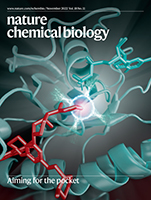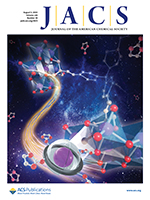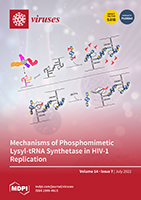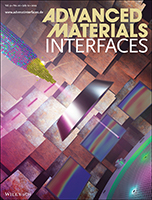Valence tautomerization in inorganic chemistry typically involves the distribution of electrons between a metal center and redox active ligand, with potential application as molecular switches or other molecular devices. Here we report an example of valence tautomerization and an unusual electronic structure in a cobalt verdazyl complex. Read more »
Journal Covers
Chemical acylation of an acquired serine suppresses oncogenic signaling of K-Ras(G12S)
Small-molecule targeting of particular KRAS mutations offer promise for cancer therapy. The cover depicts a small-molecule ligand (red) inhibiting the oncogenic mutant protein K-Ras(G12S) (cyan) by forming a covalent ester adduct at the mutant serine. Read more »
An automated size and time-resolved aerosol collector platform integrated with environmental sensors to study the vertical profile of aerosols
Researchers present the vertical distribution of size-resolved aerosol composition over an agricultural site by deploying a newly developed lightweight automated size- and time-resolved aerosol collector (STAC) platform integrated with environmental sensors on unmanned aerial systems (e.g., tethered balloon systems). Read more »
Liquid Heterostructures: Generation of Liquid–Liquid Interfaces in Free-Flowing Liquid Sheets
Microscope image of a microfluidic nozzle producing a liquid heterostructure: a layered flat liquid sheet with outer toluene layers and an inner water layer. The colored bands arise from thin film interference, indicating the presence of buried liquid‒liquid interfaces and submicron layer thicknesses. Read more »
Highly Selective Methane to Methanol Conversion on Inverse SnO2/Cu2O/Cu(111) Catalysts: Unique Properties of SnO2 Nanostructures and the Inhibition of the Direct Oxidative Combustion of Methane
Inverse catalysts generally consist of oxide nanoparticles supported on metal substrates, which can exhibit exceptional catalytic properties. The small SnO2 nanoparticles uniformly dispersed on a Cu2O/Cu(111) substrate enabled a unique SnO2–Cu2O interface that can completely convert methane to methanol directly under the environments of oxygen and water. Read more »
Versatile Sequential Casting Processing for Highly Efficient and Stable Binary Organic Photovoltaics
Ideal bulk heterojunction morphology is critical in organic solar cells (OSCs). Here, researchers show how sequential casting improves device performance in both fullerene- and nonfullerene-based systems, in which the donor and acceptor are deposited sequentially. The film spin-coating method is analogous to the traditional Chinese pancake-making process. Read more »
Ionic Conduction Mechanism and Design of Metal–Organic Framework Based Quasi-Solid-State Electrolytes
This cover image demonstrates the critical role of the solvent in the ion motion of intrinsically anionic metal–organic framework (MOF)–based quasi-solid-state electrolytes (QSSEs). Using hybrid theoretical and experimental approaches, we have identified solvent-assisted hopping as the dominant pathway for Li+ conduction in such materials, exemplified by MOF-688. Read more »
Phosphomimetic S207D Lysyl–tRNA Synthetase Binds HIV-1 5′UTR in an Open Conformation and Increases RNA Dynamics
Binding assays, RNA chemical probing, and SAXS showed that phosphomimetic S207D LysRS binds in an open conformation preferentially to dimeric HIV-1 genomic RNA. A new working model is proposed wherein a dimeric phosphorylated LysRS/tRNA complex binds to a genomic RNA dimer, facilitating tRNA primer release and placement onto the binding site. Future anti-viral strategies that prevent this interaction are envisioned. Read more »
Visualizing the Nanoscale Oxygen and Cation Transport Mechanisms during the Early Stages of Oxidation of Fe–Cr–Ni Alloy Using In Situ Atom Probe Tomography
Understanding the early stages of interactions between oxygen and material surfaces is beneficial for fields ranging from materials degradation to forensics and catalysis. In situ atom probe tomography (APT) is demonstrated to track the diffusion of oxygen and metal ions at nanoscale spatial resolution during the early stages of oxidation of a model Fe–Cr–Ni alloy. Read more »
Decoupling the metal–insulator transition temperature and hysteresis of VO2 using Ge alloying and oxygen vacancies
The VO2 metal–insulator transition underpins applications in thermochromics, neuromorphic computing, and infrared vision. Ge alloying is shown to expand the stability of the monoclinic phase to higher temperatures, and by suppressing the propensity for oxygen vacancy formation, renders the hysteresis of the transition exquisitely sensitive to oxygen stoichiometry. Read more »
- « Previous Page
- 1
- …
- 5
- 6
- 7
- 8
- 9
- …
- 21
- Next Page »









